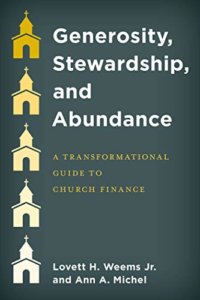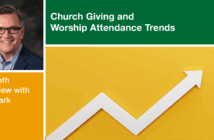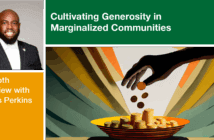Ann Michel of the Lewis Center says this could be a now-or-never stewardship moment for congregations whose pews are full of older adults. She outlines six simple steps for launching a planned giving program to help this generation faithfully steward their lifetime assets.
Those born between 1946 and 1964 (baby boomers) are the richest generation in the nation’s history. They currently control at least 70 percent of all disposable income in the country, and the estimated $30 trillion in assets they will distribute through their estates will be the largest ever generational transfer of wealth. For the many congregations whose pews are full of older adults, this is a now-or-never moment. Helping this generation of churchgoers faithfully steward their lifetime assets will be critical to the future viability of many congregations.
Yet churches typically do a poor job of encouraging gifts from lifetime assets. One reason for this failure is that no one attends to this need on an ongoing basis. Building an endowment is a classic example of something that is important but not urgent. These simple steps can help your congregation focus on this important aspect of stewardship ministry.
1. Form a planned giving team.
Just as you need a team to give leadership to your annual stewardship campaign, you need a team focused on planned giving. The members of the team might be connected to your stewardship or finance committee or may be the group responsible for the management of your endowment, but giving some individuals on the team the single responsibility of focusing on planned giving will help assure that it doesn’t get lost in the shuffle or always lose out to short-term financial planning considerations.
2. Seek guidance.
If your denomination or judicatory has a foundation, learn what assistance they can offer. Typically, a foundation can provide advice on establishing an endowment, assistance in developing a planned giving program, and investment services. Working with such a foundation is often particularly helpful for small congregations or congregations with relatively small endowments.
3. Establish a bequest policy.
Even if your church has never received a bequest, it needs a bequest policy. If you receive an unanticipated bequest without having a policy in place, pressing needs or wants from various segments of the church will likely win out over using the bequest as endowment. Also, having a policy in place signals to those considering a gift of lifetime assets that you are prepared and a worthy recipient of their gifts. Your policy should make clear your commitment to honor the restrictions on any gift you choose to accept, but also leave the option of refusing a restricted gift that does not fit you mission, values, or capabilities. The policy should also specify how unrestricted bequests will be used. A future orientation will direct them for purposes with a longer horizon than immediate needs. Generally, churches put undesignated bequests toward the endowment, the capital fund, or divide them between these two funds.
4. Educate congregants about the importance of having a will.
One of the simplest things a congregation can do to help members properly steward their lifetime assets is to stress the importance of having a will. According to Gallup research, more than half of Americans do not have a will. Even among older and upper-income Americans, 30 percent of those 65 and older and almost 40 percent of those with incomes of $100,000 or more do not have a will. The assets of those who die intestate (without a will) are distributed on the basis of state law.
Offering workshops on estate planning and wills is not only a good stewardship strategy, it is good pastoral care because it helps people tend to the needs of their heirs. But even people who understand the importance of a will are prone to procrastinating. So put a small item in your church newsletter on a regular basis explaining why a will is an important aspect of personal financial stewardship. Then, keep up the drumbeat with simple reminders in the worship bulletin or newsletter. “Have you made a will?” “Is your will up to date?” “Have you considered remembering the church in your will?”
5. Encourage proportionate giving from estates.
Whenever you discuss tithing or proportionate giving, remember to mention that it doesn’t only apply to current income. One of the simplest ways for someone to make an estate gift is to specify that a percentage of their estate go to the church. This is superior in many ways to specifying a gift of a set amount. Imagine two church members whose wills direct a $25,000 gift to the church. When they wrote their wills in 1982, that seemed like the perfect amount. But the overall value of one person’s estate multiplied over the subsequent decades, so that the amount now represented a very, very small percentage of lifetime assets, even though it seemed quite generous in 1982. The other church member’s assets had dwindled over the years due to healthcare expenses, so that the $25,000 gift was so large it prevented the person from achieving other legacy goals. As these examples illustrate, it is better to encourage people to give a percentage of their estate, hopefully at least equal to the percentage of income they gave in their lifetime. Another way to think of tithing one’s estate is to make lifetime gift that would provide ongoing income equivalent to the tithe paid during one’s lifetime.
6. Form a legacy society.
Churches and other charities often draw attention to the importance of estate giving by forming a group recognizing people who have the church in their wills. Creating such a group is a good way to start a conversation about planned giving. It encourages members to act on their intentions and celebrates the importance of making lasting gifts to the church. As a practical matter, people who are childless or whose children are grown are often the most open to considering a planned gift. An annual legacy society event is the perfect opportunity to reach out to these people and others.
In Proverbs it is written that “the good leave an inheritance to their children’s children” (Proverbs 13:22). Planning for the future is part of responsible stewardship for both individuals and congregations.
 This article is excerpted from Generosity, Stewardship, and Abundance: A Transformational Guide to Church Finances (Rowman and Littlefield, 2021) by Lovett H. Weems Jr. and Ann A. Michel. This book is available at Cokesbury, Rowman & Littlefield (Save 30% with code RLFANDF30), and Amazon. Used by permission.
This article is excerpted from Generosity, Stewardship, and Abundance: A Transformational Guide to Church Finances (Rowman and Littlefield, 2021) by Lovett H. Weems Jr. and Ann A. Michel. This book is available at Cokesbury, Rowman & Littlefield (Save 30% with code RLFANDF30), and Amazon. Used by permission.
Related Resources
- 6 Reasons Your Church Needs a Planned Giving Program by David L. Heetland
- Is Your Church Ready to Receive a Large Gift? by Ken Sloane
- 5 Reasons Not to Fear a Major Gift Campaign by Ann A. Michel






